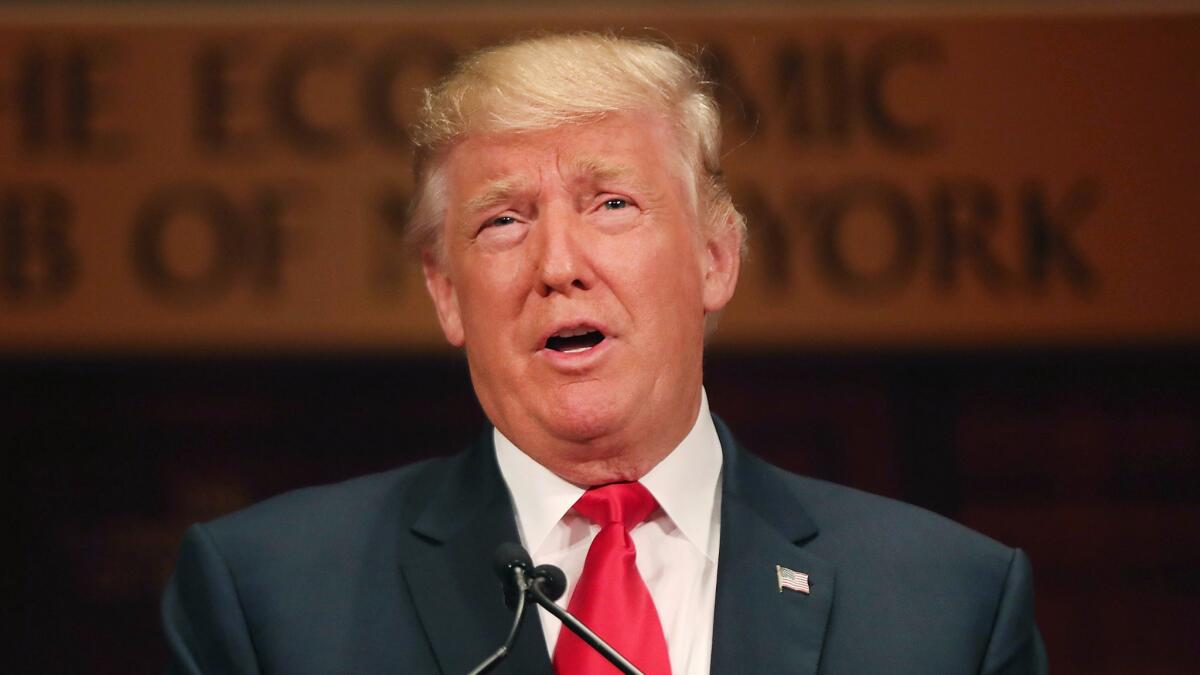If Donald Trump loses the election, launching a TV network won’t be an easy plan B

- Share via
After presidential candidates fall short in the their bids for the White House, they typically write books, make speeches and wait for the wounds of their defeat to heal.
If Republican nominee Donald Trump loses to Democratic opponent Hillary Clinton in November, some think he may return to the medium that catapulted his political career: television.
Political and media reporters have long speculated that a “Trump TV” entity is a possible backup plan for the real estate mogul, who was a reality show star before his unlikely bid for the presidency took off.
After all, Trump’s populist message has played well on television, helping to drive ratings records for the Republican primary debates on Fox News Channel, CNN, Fox and CNBC. A channel could be a platform for his famous brand name.
But Trump, now closer in the national polls to Clinton than he’s been at any point since becoming the GOP nominee, told the Washington Post that reports of launching an eponymous media business after his run are a “false rumor” and insists his focus is on winning the presidency. He also said he has never discussed the matter with Roger Ailes, the former chairman of Fox News, who has been linked to the idea. (The Trump campaign has denied reports that Ailes has advised Trump since his resignation from Fox).
If Trump changes his mind after the election results come in Nov. 8, he might find the challenge of successfully launching a new TV entity as daunting as getting 270 electoral votes for the presidency. TV executives – one of whom has worked with Trump – note that the head winds facing the cable business are tougher than ever and Trump’s polarizing personality and incendiary statements during the campaign will make it difficult for advertisers to support any media endeavor with his name on it.
After decades of expansion, the cable business has matured and is on the verge of retracting. Younger viewers are content to get their video content through Internet streaming, causing slow but steady erosion in the number of cable and satellite customers. Cable and satellite operators are taking a harder line on paying fee increases for channels when contracts come up. The cable business is now finding ways to offer consumers the option to pay for fewer channels, not more.
Those factors present a high barrier for anyone considering launching a new programming service, not just Trump.
“It’s extremely difficult to get carriage right now,” said Derek Baine, a senior analyst for SNL Kagan. “You’re hearing all of the media executives talk about taking channels off, not putting channels on. It’s not independent channels having a hard time. It’s everybody.”
Baine said the industry’s downturn is reflected in two widely distributed cable channels – Al Jazeera America and Pivot – shutting down this year after their owners each made investments of $500 million to get them off the ground.
“It’s really shocking that nobody would buy them and re-brand them and try to do something else with them,” Baine said. “That gives you a clue of how hard it is in this particular environment.”
Even during cable’s growth years, the investment required to get carriage on cable and satellite systems could be huge. Fox News Channel is now among the most profitable media entities, commanding higher rates in recent carriage negotiations. But the success came after years of parent company News Corp. (now 21st Century Fox) paying millions of dollars to get video providers to take it when it was first launched as an upstart competitor to CNN 20 years ago.
Election 2016 | Live coverage on Trail Guide | Sign up for the newsletter
Other successful channels also had to wait for years to get a return on their investment. E.W. Scripps’ Food Network was offered to cable and satellite operators for free for years before the company could start collecting subscriber fees, which typically account for about 60% of a network’s revenue. Even a seemingly surefire idea of a cable network built around a beloved celebrity such as Oprah Winfrey (Discovery Communications’ OWN) took several years and a programming revamp to achieve profitability.
If a channel built around Trump could get carriage, his inflammatory comments – including remarks about Mexican immigrants, who he described as rapists and murderers – would potentially keep major advertisers away from a channel with his name on it.
Even a single show that featured Trump as a host would be problematic unless he worked at dissuading detractors who see him as racist and sexist.
“I don’t believe any advertiser-supported service will touch him,” Jeff Gaspin, a former NBC executive who ran the network’s entertainment division when Trump was the star of its hit reality show “The Apprentice.” “If he wants something more mainstream there would have to be a period of healing.”
Trump’s appeal among voters is strongest among older voters in rural parts of the country. That is not a coveted target audience for Madison Avenue, which always pays higher ad rates for young consumers in urban centers.
Still, Trump’s followers in the heartland states who want an alternative to New York-based media outlets (some of whom believe even Fox News is not conservative enough) could provide enough of an audience for a subscription video on demand, or SVOD, channel. Such an entity would be quicker and far less expensive to launch than a traditional cable or satellite network, which would require about a $200-million investment. An SVOD channel, whose subscribers pay a monthly fee to receive it on a digital device or Internet-connected television, could be launched for one tenth of that amount.
The model for such an outfit would be the Blaze, the SVOD channel launched in 2011 by libertarian talk show host Glenn Beck after he left Fox News (where controversial remarks on his program had driven advertisers away). The Blaze has never released subscriber numbers, but the channel reportedly has an estimated 400,000 subscribers who pay $9.95 a month. It also gets distributed to satellite customers on the Dish Network.
“It doesn’t cost that much because you don’t need a huge infrastructure,” said Neal Shapiro, the former president of NBC News who is now a public TV station executive in New York. “You need some studios. Your biggest costs would be big personalities and Trump would be the biggest. And he owns him.”
But Shapiro raised doubts as to whether Trump’s off-the-cuff style could sustain a daily show that would be needed to anchor a full-time channel.
“What made ‘The Apprentice’ work is his ‘You’re fired’ shtick,” Shapiro said. “Trump’s not a deep political thinker. It’s not like, ‘if you care about policy this is a guy you’re going to watch.’ People who are into politics like that, especially on the right, want new stuff. Glenn Beck knows how to develop a well-produced rant.”
Even though Trump has plenty of TV experience, there is no guarantee the angry disenfranchised voters who support him will still want to hear from him after the election if he loses. Shapiro recalled his own experience when he signed former wrestling star turned Minnesota governor Jesse Ventura to host a program on cable network MSNBC and found that as compelling a speaker as he was, he had trouble filling air time.
“Jesse Ventura’s charm was ‘the system isn’t working and here’s a plain-spoken guy who is smarter than you think,’” Shapiro said. “What we found out was he’s not close to a policy wonk or a standard politician. It gets old kind of fast.”
Twitter: @SteveBattaglio
MORE POLITICS NEWS
Why the USC/L.A. Times tracking poll differs from other surveys
Top Clinton Foundation donor who was denied entry into the U.S. fires back with a lawsuit
More to Read
From the Oscars to the Emmys.
Get the Envelope newsletter for exclusive awards season coverage, behind-the-scenes stories from the Envelope podcast and columnist Glenn Whipp’s must-read analysis.
You may occasionally receive promotional content from the Los Angeles Times.









